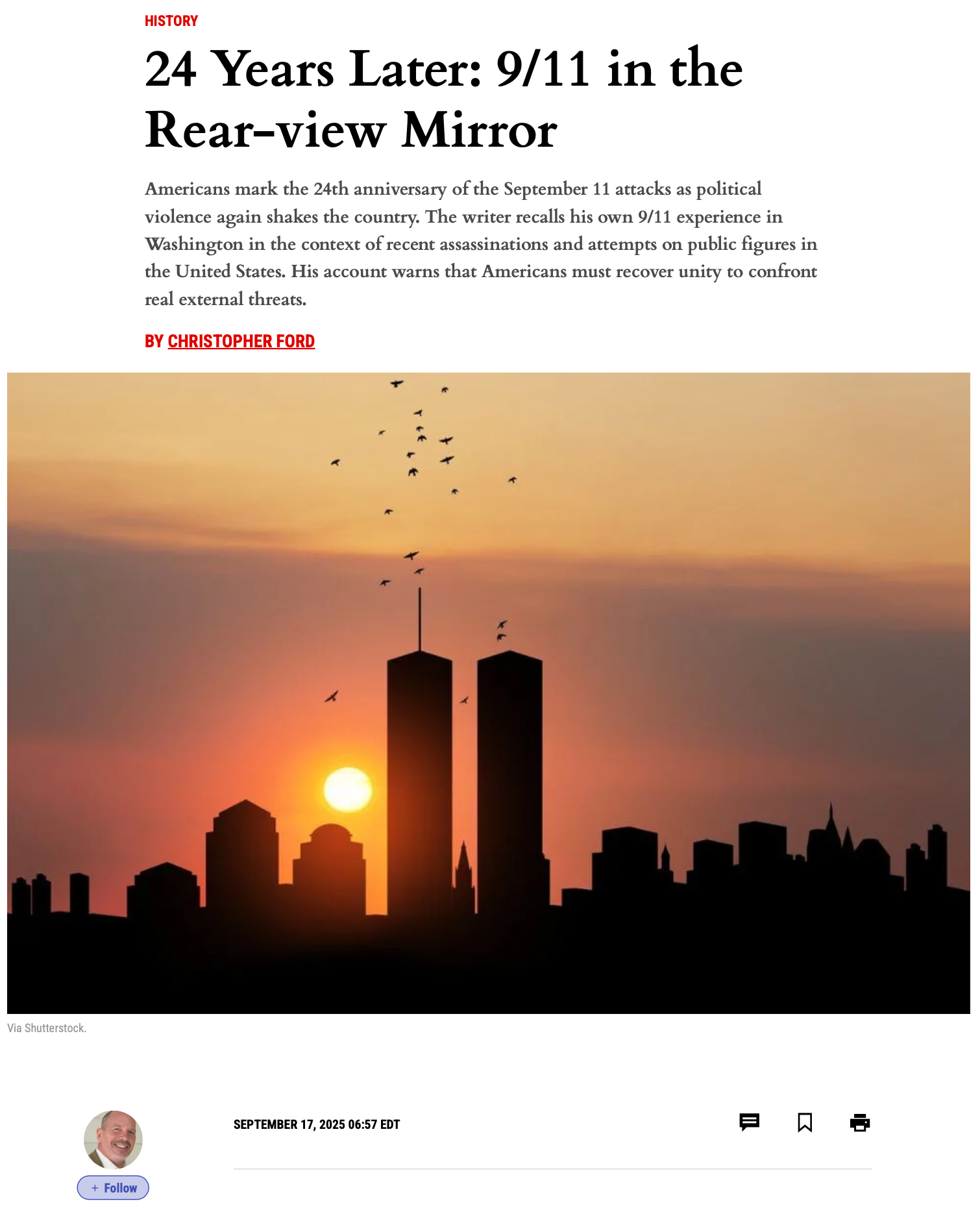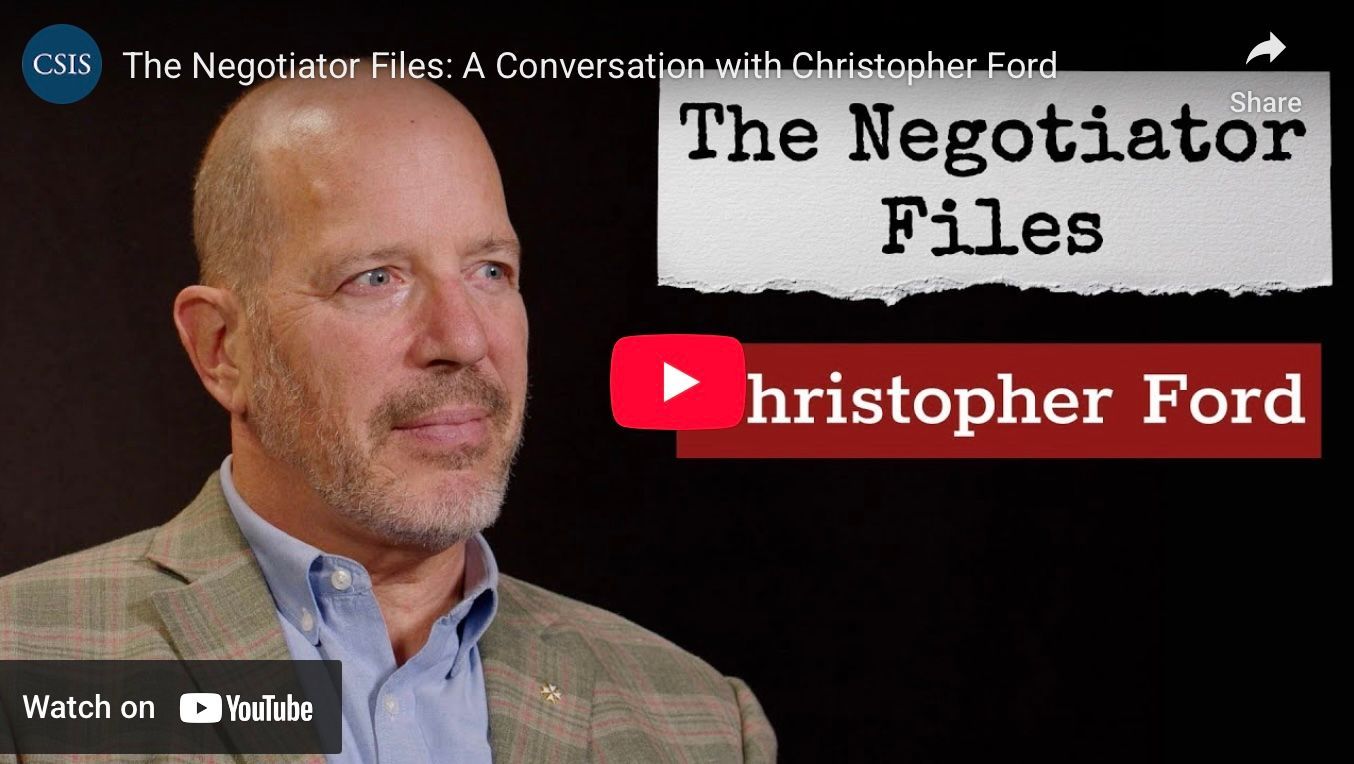Geopolitical Risks and the U.S.-China Relationship
Below is the prepared text upon which Dr. Ford based his (much) shorter remarks on a panel on geopolitical risk on November 18, 2025, sponsored by Forward Global and the Oxford University Alumni Network.
Good afternoon fellow Oxford alumni, and thanks for having me be a part of this event. I can only offer my personal views, of course – and I’m not speaking here on behalf either of my two primary institutional affiliations, Missouri State University’s School of Defense and Strategic Studies or the Center for Strategic and International Studies. But I’m happy to offer what thoughts I can.
A Cautionary Note
To begin with, as a cautionary note, I can’t help but observe that it’s difficult to be “right” about which hypothesized global risks are ones that will actually materialize. Many risks have been hyped before and haven’t panned out.
I remember being told as a kid in the 1970s, for example, that the human population was growing out of control, that our numbers would soon outstrip mankind’s ability to produce food, and that billions of people would starve to death – that is, if we didn’t die first from the chemicals with which we were poisoning our air and water. At a time when the United States and the Soviet Union faced each other in a ferocious Cold War rivalry with scores of thousands of nuclear weapons on each side, moreover, many folks expected we’d probably incinerate ourselves long before that inevitable ecological apocalypse, leaving only cockroaches to enjoy all that polluted land if they didn’t freeze first from “nuclear winter.” To top it off, we were then said also to be passing “peak oil” and that our economies were thus destined to collapse into energy starvation.
Yet today, the Cold War is over, Washington and Moscow still compete in the nuclear weapons arena, but their arsenals nonetheless now stand at a fraction of their Cold War peaks, and there isn’t even a Soviet Union at all anymore. At the same time, many seem to feel today that the world actually doesn’t have enough people, or at least that declining fertility rates will soon create a demographic crisis of underpopulation. Meanwhile, we’re now said to be producing far too much energy, which will lead to a climate crisis of global warming that will kill a great many of us and much of the rest of the biosphere besides – at least if ruthlessly sentient Artificial Intelligence (AI) bots don’t preemptively murder or enslave all us inconveniently biological beings along the way to ensuring computational silicon’s mastery of the globe.
To be sure, today’s doomsaying might actually be right, and maybe we really are in conclusively catastrophic trouble for all these much-talked-of reasons. But history should probably serve as a reminder that for better or worse, Yogi Berra was correct that “it’s tough to make predictions, especially about the future.”
Risk in the U.S.-China Relationship
Nevertheless, let me try to answer your question about geopolitical risk in the U.S.-China relationship. In this respect, I’d like to point to four dynamics that together create particularly acute geopolitical risk right now, and that layer onto – or perhaps exacerbate – the trends and risks that your other guests today have already mentioned.
The first is the intrinsic risk of geopolitical destabilization from emerging and disruptive technologies (EDTs), the second is the deterioration of the modern information space, the third is the ongoing threat from weapons of mass destruction (WMD) proliferation, and the fourth is the Chinese geopolitical ambition that has helped create a fierce competitive and increasingly hostile great power rivalry between United States and China. These dynamics, moreover, are related, for each has the potential to exacerbate and accelerate the others – and, I think, each does.
Emerging and Disruptive Technologies
As for EDTs, those of us in the nonproliferation community know well that even a single technological advancement canhave huge geopolitical ramifications, as of course occurred with the development of nuclear technology. But more potentially significant is the way in which entire interconnected suites of technological innovation can rapidly transform the global system.
We’ve known this is possible since new scientific and technological (S&T) knowledge transformed everything as a result of the First Industrial Revolution some two centuries ago, which really could be said to have created the modern world.
Today, many believe a new suite of radical and interconnected technological changes are likely to transform things again. Most expect this charge to be led by advances in AI, but hugely transformative possibilities also exist with other EDTs such as quantum computing and various novel biological science applications, particularly where such rapidly-evolving technologies intersect, overlap, and reinforce each other’s disruptive potency.
To be sure, such disruption can produce many good things: think, for instance, of the impact of the First Industrial Revolution on transportation, health care, communications, and all sorts of other aspects of daily life.
But remember, too, that the economic, technological, and military advantages that accrued to those countries with “first mover” (or “earlier mover”) advantages in that revolution also turned geopolitics on its head, creating huge new asymmetries in power as some countries reached technological modernity far in advance of others. These asymmetries made possible a century of European politico-economic domination and imperialist expansion around the world.
Since such transformative science and technology (S&T)-driven changes can be so disruptive, it follows that should be rather uneasy about where today’s flush of technological change – which some have described as portending a new Industrial Revolution – may take us. Such change is indeed likely to bring lots of good things, but it may also upend geopolitics yet again, to uncertain and potentially very dangerous effect. Hence geopolitical risk.
The Collapsing Global Information Space
Another development that I think entails geopolitical risk relates to the decay of the global information space in an epistemological crisis that seems increasingly – and for perhaps the first time in centuries – to have deeply destabilized the very idea of objective knowledge and the possibility and means of seeking it. To be sure, so-called social media is hardly the sole villain in this story, but it’s one worth flagging for the divisive informational and ideational polarization that it has helped create. Deliberate epistemologically-destabilizing disinformation has also played a powerful role, originating not only from willful disruptors such as Russian and (increasingly) Chinese propagandists, but also from domestic actors who have learned to win political advantage from hyperscaling intellectually empty but incendiary informational flatulence, turning critical matters of national policymaking into mere opportunities for polarizing ideological performance art and tribalistic political onanism.
Whatever the many contributing factors, however, our age and our societies have clearly become desperately fractured by these dynamics. This is bad enough on its own terms, but it also has the side effect of retarding our ability – as a society, as a country, and as an international community – to handle the other geopolitical challenges I’m describing. These dynamics of information-space decay threaten to make thoughtful decision-making, policy consistency, and real strategy all but impossible, mitigating instead in favor of volatile extremism as the policy pendulum swings between reflexively outraged, provocative, and performative militancies of the Right and the Left without ever slowing around anything that looks like real policymaking seriousness.
WMD Proliferation
Third, I wouldn’t be much of a nonproliferation policy guy, if I didn’t also mention the geopolitical risk of weapons of mass destruction (WMD) proliferation. But it’s all too real.
Potential proliferation, and especially nuclear proliferation – either to “rogue regimes” with disruptively self-aggrandizing geopolitical agendas or to “friendly proliferators” who are worried about existential threats from great powers with such disruptive geopolitical agendas – has long been a threat. Yet, on the whole, the international system handled such pressures tolerably well during the Cold War years of alliance block bipolarity and the early post-Cold War years of American-dominated systemic unipolarity.
I am less convinced, however, that these WMD proliferation pressures are manageable in the emerging era of multipolar rivalry. It will likely be far harder to handle these challenges today, given the growth of Chinese military power and its destabilizing effect upon East Asian geopolitics, the return of naked ambitions of territorial expansion in Europe as Russia wages wars of annexation and conquest against its neighbors, the prospect of further such wars of territorial expansion by China (e.g., against Taiwan) in the Indo-Pacific, the paralysis of international institutions due to great power rivalry, and the recent rise of quasi-isolationist political elites in America who do not prize alliance relationships and look rather askance on overseas commitments. From a proliferation perspective, the coincidence of these factors is quite a toxic and dangerous brew.
Chinese Ambitions of Global Predominance
The fourth dynamic I’d like to flag – Chinese ambitions of global predominance – intersects these other three dynamics in worrying ways. In the context of strategic competition exacerbated by such ambitions, for example, the huge impact of EDT-driven change can have on the relative power some countries have over others becomes particularly significant and potentially destabilizing. Asymmetries of power exacerbated and accelerated by S&T-driven change also increase WMD proliferation pressures, even while the collapsing information space in Western democracies makes a coherent and sustained response to geopolitical risk harder to achieve.
But let’s unpack those Chinese ambitions a bit. Not that long ago, the Chinese Communist Party (CCP) still followed Deng Xiaoping’s famous exhortation about “biding one’s time and hiding one’s capabilities,” and it tempered its rise as an economic superpower with policies of non-provocative military and strategic prudence and circumspection. As its power grew, however, China became impatient with such strategic cautiousness, and has clearly now thrown it aside in favor of open self-assertion.
Geopolitical impatience and self-confidence now rule the day in Beijing, and “hiding and biding” has been replaced by unabashed self-assertion as China seeks to achieve its “national rejuvenation” ambition of returning to the position of geopolitical centrality of which Chinese nationalists feel China was robbed by European and Japanese imperial power in the 19th Century. It should be quite clear by now that despite the carefully mollifying reassurances of Chinese diplomats during the “hiding and biding” period, China’s rise is really about far more than merely making the country and its huge population prosperous, safe, and comfortable.
It is also about power, and about Beijing’s desire to re-acquire the systemic centrality and norm-setting primacy that its romanticized vision of its own history as the “Middle Kingdom” – a term was always really more a systemic label than a geographic one – leads its leaders to conclude is China’s birthright and destiny. For an international system that is full of countries bristling with increasingly sophisticated and destructive weapons, wrapped in global interdependencies, and facing a potential whirlwind of transformative technological change – not to mention the core values of which still prize national sovereignty and autonomy and anathematize vassal state subjugation – China’s systemically disruptive ambitions present considerable geopolitical risk indeed.
To judge from what Xi Jinping has himself said, China believes a transformative “Fourth Industrial Revolution” is coming, and Beijing is determined to ensure that it – rather than the United States – sits in the “first mover” driver’s seat for this new revolution.
As officials in Beijing see it, it was the First Industrial Revolution that permitted its “first mover” – Great Britain – to acquire vast global power. Indeed, the world in some sense reordered itself around British economic, trading, scientific, and military might, helping make the 19th Century “Britain’s century.” And it is said to be, in turn, the Second and Third Industrial Revolutions that enabled America to dominate the 20th and early 21st Centuries.
So when Xi Jinping pledges China to the task of seizing the commanding heights of the coming Fourth Industrial Revolution, he is clearly signaling China’s aim to acquire an analogous position of relative power and systemic dominance for itself.
Not surprisingly, this conduces to geopolitical risk.
To be sure, the disruptive impact of these dynamics would likely be less if the United States succeeded in acquiring first mover” status in a Fourth Industrial Revolution than if China did, for America has already been the globally dominant power for many years, and its “victory” would, so to speak, break less geopolitical crockery.
By contrast, China’s success in Xi’s project to lead that revolution would change more things and present greater dangers to the many states whose sovereignty, democratic governance, and political autonomy have for many decades been protected by the existing international order and America’s power within it. A new Sinocentric order could thus be verydangerous to the sovereignty and autonomy of such states.
But make no mistake: the conjunction of rapid EDT-driven transformative change and great power rivalry represents a considerable geopolitical risk either way. No matter who “wins,” the prospect of these two giants competing for power and advantage in a world where S&T innovations can rapidly result in transformatively disruptive changes not just in economic but in military power is certainly something to worry about.
Conclusion
This all amounts to a pretty intimidating concatenation of geopolitical risks. But I hope our discussions today will help encourage more creative thinking about how to handle them.
—Christopher Ford








